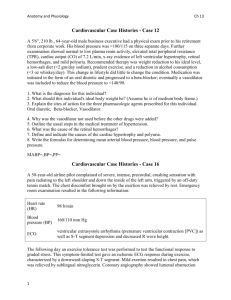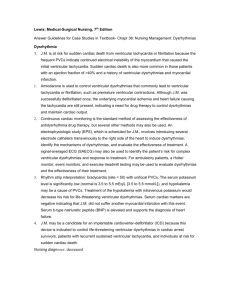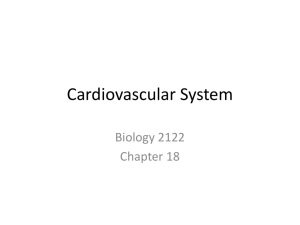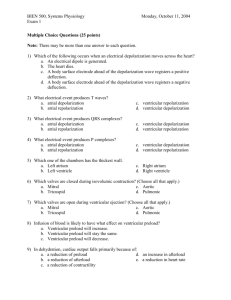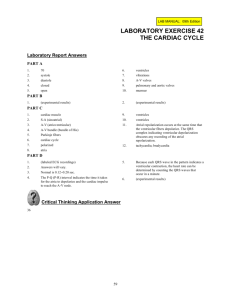NUR 4206 By Linda Self
advertisement
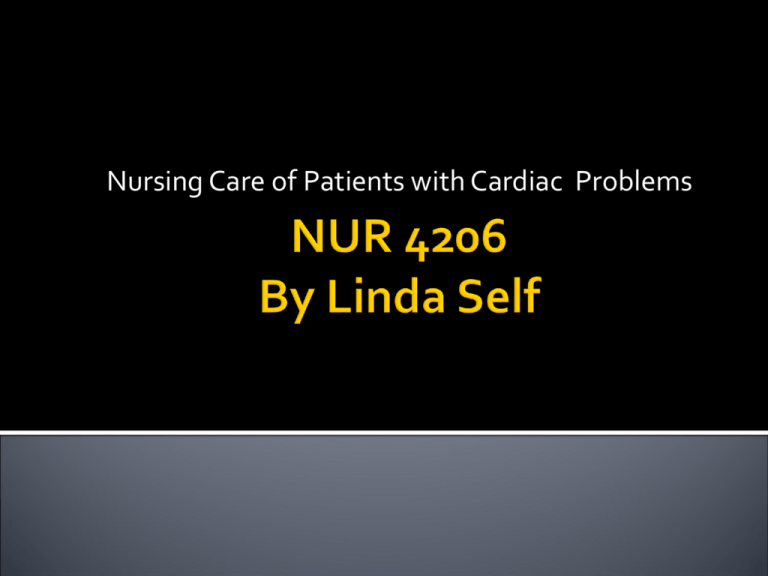
Nursing Care of Patients with Cardiac Problems One in five Americans possess some form of cardiovascular disease With increase in metabolic syndrome and aging babyboomers, numbers increasing Cardiovascular disease is the number one cause of death in women in US. Major cause of mortality in 21st century Number of cardiovascular problems that can occur Pericardium Epicardium Myocardium Endocardium Right side of heart—workload is light compared to left side; pulmonary circulation Left side of heart—high pressure system, systemic circulation S1 caused by closure of mitral and tricuspid valves S2 caused by the closure of aortic and pulmonic valves Splitting of S1 and S2 can be accentuated by inspiration Gallops=S3 and S4 S3 is ventricular gallop—normal in children. In those over 35, indicates early heart failure, VSD or decreased ventricular compliance S4 is an atrial gallop—seen in hypertension, anemia, aortic or pulmonic stenosis and pulmonary emboli Systolic murmurs—aortic stenosis and mitral regurgitation. Occur between S1 and S2. Diastolic murmurs—aortic or pulmonic regurg and mitral stenosis. Occur between S2 and S1. Grades I-VI; 1 very faint, 2 faint but recognizable, 3 loud but moderate in intensity, 4 loud w/thrill, 5 loud, thrill, stethoscope partially off chest, 6 audible w/o stethoscope Heart perfused by coronaries during diastole Right coronary Left coronary Circumflex Must be 60-70 to maintain perfusion of vital organs Left coronary perfuses left ventricle, septum, chordae tendinae, papullary muscle and portion of right ventricle Right coronary—supplies right atrium, right ventricle, inferior portion of left ventricle Automaticity—intercalated discs Conductivity Contractility Excitability Cardiac conduction system 1. SA node 2. Internodal tracts 3. AV node/junction 4. Bundle of His 5. Right and left bundle branches 6. Purkinje fibers Stimulation of the cardiac working cells (myocytes) is reliant on exchange of ions across particular channels in cell membrane Channels regulate the movement and speed of the ions, specif., sodium, potassium, and calcium Sodium travels across fast channels, calcium across slow channels Potassium is primary intracellular ion, sodium is the primary extracellular ion Phase O—cellular depolarization initiated as positive ions influx into cell. Sodium moves rapidly into myocytes; depolarization of SA and AV nodes via slow calcium channels Phase 1—Early cellular repolarization occurs as potassium exits intracellular space Phase 2—plateau phase, rate of repolarization slows, calcium ions enter intracellular space Phase 3—Marks completion of repolarization and return of the cell to resting state Phase 4-resting phase before next depolarization During this phase, cells are incapable of being stimulated Absolute refractory period—unresponsive to any electrical stimulus, Phase O to middle of Phase 3 Relative refractory period—brief period at end of Phase 3. Strong enough impulse can cause depolarization prematurely. This increases the risk for serious dysrhythmias. Factors increasing likelihood of premature depolarization Hypokalemia Hypomagnesemia Hypothermia Myocardial injury Acidosis hypercarbia P wave-atrial depolarization PR-duration of time from SA to AV nodes QRS-ventricular depolarization QT-total time needed for depolarization and repolarization T wave-represents ventricular repolarization U wave if prominent represents electrolyte abnormality Calculate heart rate Heart rhythm Analyze P waves Measure P-R interval Measure QRS duration Interpretation PR interval <.20 second QRS interval < or equal to .12 second QT interval variable, generally less than .42 second P for every QRS l Normal sinus rhythm—60 to 100 Sinus dysrhythmia Tachydysrhythmias-->120 Bradydysrhythmias--<60 Premature complexes Repetitive rhythms—atrial flutter Escape complexes—idioventricular rhythm Sinus tachycardia Sinus bradycardia Supraventricular rhythms Atrial fibrillation or flutter 1st, 2nd, 3rd degree heart blocks Vtach, Vfib, asystole Based on principle that fluid flows from region of higher pressure to one of lower pressure Right side of heart has lower pressure than does left Systole-pressure in ventricles increases, forces AV valves to close, forces semilunar valves to open, and blood is ejected Diastole—ventricles are relaxed, AV valves open, atria fill first, ventricles fill, electrical impulse, atria contract, impulse is propagated to ventricles, ventricles fill then will contract HR x SV= CO Ranges between 4-7 L/min in adults CI = CO divided by BSA Amount of blood pumped by each ventricle during given period Stroke volume is amount of blood ejected per heartbeat, ~70ml Affected by preload—degree of stretch of cardiac muscle fibers at the end of diastole, amount of blood returning to right side of heart afterload –amount of resistance to ejection contractility—force generated by the contracting myocardium Ejection Fraction--Percentage of enddiastolic volume that is ejected, ~50-70% Pulmonary vascular resistance (PVR)— resistance of the pulmonary BP to right ventricular ejection Systemic vascular resistance (SVR)— resistance of the systemic BP to left ventricular ejection Contractility=force of generated by the contracting myocardium Increased size of left atrium Thickening of endocardium Myocardial thickening Thickening and rigidity of AV valves Calcification of aortic valve Decreased number of SA, AV, Bundle of His, right and left bundle branch cells Stiffening vasculature Decreased sensitivity to baroreceptors Cigarette smoking Genetics Physical inactivity Obesity Hyperlipidemia Diabetes mellitus Hypertension History Chest pain or discomfort SOB Peripheral edema and weight gain Palpitations Fatigue Dizziness, syncope, changes in level of consciousness Angina pectoris Pericarditis Pulmonary disorders—pneumonia, PE Esophageal disorders Anxiety and panic disorders Musculoskeletal disorders--costochondritis Atypical presentation Fatigue, sleep disturbances, shortness of breath Historically undertreated due to ambiguous presentation General appearance and cognition Inspection of the skin Blood pressure—difference between the systolic and diastolic blood pressure is called the pulse pressure. Pulse pressure less than 30 torr signifies a serious reduction in cardiac output and requires evaluation Postural BP changes Arterial pulses, pulse quality-check side to side JVD when head of bed is elevated 45 to 90 degrees Heart sounds—S1, S2 ; gallops (vibration), snaps and clicks (stenosis of mitral valve), murmurs (turbulent flow) and friction rubs (harsh grating sound) Inspection of extremities Lungs Abdomen Skin temperature Assess clubbing by the Schamroth method Blood pressure—hypertension Prehypertension—120-130/80-89 Postural hypotension—BP decrease by 20 torr systolic or 10 torr diastolic plus 10-20% increase in heart rate. Supine,sitting, standing. Ankle-brachial index=assess vascular status of LE. LE SBP divided by brachial BP. Should be 1, .8 moderate disease, .5 severe Changes in AP diameter Isolated systolic hypertension—increases risk for morbidity and mortality S4 will be present in ~90% of elderly patients due to decreased ventricular compliance S2 may be split 60% of elderly have murmurs, reflective of sclerotic changes of aortic leaflets Cardiac biomarkers Creatine kinase and CK-MB—most specific in MI Myoglobin—heme protein. Released from myocardial tissue within 1-3 hours after injury. Less specific as may be elevated in renal and musculoskeletal disease Troponin T and I—proteins found only in cardiac muscle, detected within 3-4 hours, peak in 4-24 and remain elevated for 1-3 weeks Lipid profile—obtain after a 12 hour fast Brain (B type) Natriuretic Peptide— neurohormone that regulates BP and fluid volume. Level increases as increased ventricular pressure as seen in heart failure. >51.2 is considered abnormal. C Reactive Protein—protein released by liver and reflects systemic inflammation. Normal is less than 1.0 ECG—graphic recording of the electrical activity of the heart. Up to `18 leads. Telemetry—radiowaves Holter monitoring Wireless mobile cardiac monitoring Exercise stress test Pharmacologic stress test—Persantine and adenocard are given, simulate effects of exercise; dobutamine also, helpful on those with bronchospasm Total cholesterol 122-200 Triglycerides—122-200 HDL—55-60 LDL—60-180 HDL: LDL ratio—3:1 Homocysteine—indicates risk for CVD. Linked to development of atherosclerosis. 12hour fast needed for reliable monitoring of level. Normal 5-15 micromol/L Magnesium—necessary for absorption of calcium, maintenance of potassium stores and metabolism of ATP. Low levels predispose to atrial and ventricular dysrhythmias. Increased levels depress contractility and excitability of heart. Echocardiography—noninvasive ultrasound that is used to examine the size, shape and motion of cardiac structures. Transesophageal echocardiogram (TEE)— provides clearer images of heart . Fasting for 6 hours. IV line. Sedation. Throat anesthetized. Frequent monitoring. Thallium or Cardiolite stress test PET scan can be used to measure cardiac dysfunction MRI Cardiac catheterization with angiography— contrast, know BUN/creatinine, INR, PT, PTT Must be fasting. Have IV access. Following cath, observe catheter access site for bleeding Monitor extremity—CSM Bedrest for 2-6 hours Monitor for dysrhythmias Monitor for contrast agent induced renal failure, I&O, hydration Ensure patient safety—instruct no lifting for 24h, no straining, avoid tub baths, s/s of bleeding, swelling, bruising, pain or fever Class IA— Na+ channels.Depress depolarization, prolong repolarization. For atrial and ventricular dysrhythmias. Pronestyl (procainamide). Proarrhythmic. Lupus-like syndrome. Class IB—minimal depression of depolarization, shortened repolarization. Treats ventricular dysrhythmias. Xylocaine (lidocaine) and Mexitil (mexilitene). CNS changes. Case Studies Class IC—marked depression of depolarization; little effect on repolarization. Tx of atrial and ventricular dysrhythmias. Tambocor (flecainide) and Rythmol (propafenone). Proarrhythmic, HF, AV blocks Class II—Beta blockers.Decrease automaticity and conduction. Treats atrial and ventrcular dysrhythmias. Tenormin (atenolol), Lopressor (metoprolol), Inderal (propranolol), bradycardia, heart failure, bronchospasm, masks hypoglycemia Class III—Potassium channels. Prolong repolarization, for atrial and ventricular dysrhythmias especially when ventricular dysfunction present. Cordarone (amiodarone), Corvert (ibutilide). SE: pulmonary toxicity, corneal microdeposits, bradycardia, AV blocks, heart failure, hypotension with IV administration, peripheral edema. Class IV—block calcium channels. For atrial dysrhythmias. Cardizem (diltiazem), Calan (verapamil). Bradycardia, AV blocks, Hypotension, peripheral edema Timed electrical current to terminate a tachydysrhythmia Defibrillation-treatment of choice for ventricular fibrillation and pulseless VTach Electronic device that provides electrical stimuli to heart muscle Composed of generator and electrodes Universal code about function Appropriate sensing of intrinsic rhythm, appropriate pacing and appropriate capture Complications include: infection, bleeding,ectopy, performation of myocardium Universal code indicates five letters 1. Identifies chamber being paced. V, A, D (dual). 2. Indicates chamber(s) being sensed. A, V, D, O (meaning sensing function is off) 3. Indicates type of response to the sensing. Inhibition and Triggered responses. I, T, O. 4. Used only with permanent pacemakers. Ability to modulate rate and increase CO during times of increased cardiac workload. Indicated by letters O(none) or R (rate modulation) 5. Indicates multisite pacing capability. A, V, D or O. So pacemaker that is VVIOO would indicate? DDIRD. Infection at entry site Bleeding and hematoma hemothorax Ventricular ectopy Diaphragmatic stimulation (hiccuping) Inhibition of permanent pacemakers when exposed to strong electromagnetic interference (keep cell phones at least 6 inches away from pacer, not keep in shirt pocket. Nonsensing Noncapture Nonpace Detects and terminates life-threatening episodes of tachycardia or fibrillation Used in those who have survived sudden cardiac death syndrome Also useful in those with CM and with prolonged QT syndrome Invasive procedure used to evaluate and treat various dysrhythmias that have caused serious symptoms Identifies impulse formation Assesses dysfunction of SA and AV nodes Maps location of dysrhythmogenic foci Assesses effectiveness of antiarrhythmias Allows for ablation Inflammation affecting arterial walls Results in plaque formation Impedes flow Results in atherosclerosis High lipids Smoking Hypertension Diabetes mellitus Family history Metabolic syndrome Cholesterol Tobacco use Weight Hypertension Diabetes mellitus Total fat—25-35% of total calories Saturated fat<7% Polyunsaturated fat --up to 10% of total calories Monounsaturated fat—up to 20% of total calories CHO 50-60% of total calories Fiber—20-30gm per day Protein 15% of total calories Cholesterol--<200mg/day HMG-CoA Reductase Inhibitors (statins): Mevacor (lovastatin), Pravachol (pravastatin), Zocor (simvastatin), Lescol (fluvastatin), Lipitor (atorvastatin), Crestor (rosuvastatin); decreases LDL* and TG, increases HDL Nicotinic Acid: Niacin; decreases LDL and TG*, increases HDL* Fibric Acids: Tricor (fenofibrate); decreases LDL Bile Acid Sequestrants: Welchol (colesevelam), decreases LDL Increase endothelial cell function Reduce degradation of plaque matrix Anti-inflammatory Reduce oxidation of LDL and uptake of macrophages Reduce platelet aggregation/alter fibrinogen levels Reduce smooth muscle proliferation Vytorin—controversial at this time Zetia (ezetimibe)—selective cholesterol absorption inhibitor Lovaza (omega 3 fish oil)—need 3-4 gms per day, good in hypertriglyceridemia Promote smoking cessation-Nicoderm, Zyban (bupropion), Chantix Manage hypertension—prehypertensive if BP > 120/80; inflammatory process Control diabetes—hyperglycemia promotes dyslipidemia, increased platelet aggregation, increased thrombus formation; impair endothelial cell-dependent vasodilation and smooth muscle function CV catch up to men 10 years after menopause Twice as much CAD in African-American women than in Caucasian women Historically, gender related differences in Tx With menopause, risk factors escalate Debate re HT (hormone Therapy) Stress--catecholamines Clinical syndrome characterized by episodes or paroxysms of pain or pressure secondary to insufficient coronary blood flow; decreased oxygen supply Caused by atherosclerosis Obstructions of coronaries Stable angina—occurs on exertion Unstable angina—crescendo, threshold lower, sometimes pain at rest Refractory angina Variant angina-vasospasm, reversible ST elevation Silent ischemia—ECG changes but w/o symptoms Pain poorly localized Viselike, substernal More diffuse in women as affects long segments of artery rather than discrete segments Diabetic may have blunted response due to damaged nociceptors Feeling of weaknes, SOB, diaphoresis May subside with nitro Presentation in elderly may be less specific ECG Echo Stress test CRP Cardiac cath or angiography Decrease oxygen demand and increase oxygen supply Pharmacologic therapy Reperfusion therapies (percutaneous coronary interventions such as atherectomy, intracoronary stents and PTCA) Nitrates mainstay Beta blockers—reduce myocardial oxygen consumption Calcium channel blockers—decrease SA node conduction, decrease workload, decrease BP, decrease vasospasm. Norvasc (amlodipine) , Cardizem (diltiazem) Antiplatelet and anticoagulant medications 1. ASA 2. Plavix (clopidogrel) and Ticlid (ticlopidine) 3. Heparin (HIT), Fragmin or Lovenox 4. Glycoprotein IIb/IIIa agents (ReoPro (abciximab) and Integrilin (eptifibatide))— prevent adhesion of platelets with fibrinogen 5. oxygen Assessment—presentation, description of pain Treat anginal symptoms—ntg, O2, vitals Reduce anxiety Prevent pain Teaching F/U Permanent injury Reduced blood flow in coronary artery due to rupture of plaque Synonymous =coronary occlusion, heart attack, MI “time is muscle” ST elevation, non-ST segment elevation, location of injury (anterior, inferior, posterior, lateral wall) Q wave Clinical manifestations chest pain, discomfort, pressure SOB Indigestion, nausea Anxiety Diaphoresis Like patient with angina ECG—damaged cells will have changes in repolarization and depolarization; T wave inversion, ST segment changes, Q wave (no depolarization through this tissue) Echo to evaluate ventricular function Labs—CK, MB (cardiac specific) peaks in 24h; troponin (critical marker, may remain elevated for weeks), myoglobin (earliest but less specific) Rapid transit to hospital 12 lead within 10 minutes, serial ECGs Labs, biomarkers Cxray (establish baseline) O2, Ntg, MS, ASA, beta-blocker, ACEI in 24h Evaluate for indications for reperfusion Tx— PCI, thrombolysis Continue therapy—Plavix, IV heparin, Glycoprotein IIb/IIIA inhibitors Bedrest 12-24h Rehab—gradual physical conditioning PTCA—angina, intervention to open blocked coronaries Coronary stents—metal mesh that provides structural support to vessel Atherectomy Brachytherapy—radioisotope may be delivered by catheter or implanted with stent Dissection Perforation Vasospasm MI Dysrhythmias Cardiac arrest Bleeding from insertion site Hematoma GIIa/IIIb agents Pressure over femoral sheath insertion site Leg straight for several hours (varies accord. to size of sheath used, amount of anticoagulant and physician preference) Watch site for hematoma Indicated when unable to control angina w/meds and PCI Treatment of left main coronary stenosis or multivessel CAD Treatment for complications from an unsuccessful PCI Indicated when coronaries with >70% occlusion (60% in left main coronary) Saphenous or internal mammary arteries used for grafts Assess: 1. Respiratory status 2. Cardiac status 3. Neurologic status 4. Peripheral vascular status 5. Renal function 6. Fluid and lytes 7. Pain 8. Family needs Ett and vent ECG Swan-Ganz catheter—hemodynamic monitoring Pacemaker Aline Chest tubes Neuro status NG tube Foley Surgical sites Restore cardiac output Promote gas exchange Maintain fluid and electrolyte balance Minimize sensory-perception imbalance Relieving pain Maintaining adequate tissue perfusion Maintaining normal body temperature Inflammation of the pericardium Caused by: idiopathic, infection (usually viral), CT disorders (SLE), MI, neoplasia, radiation therapy, trauma, renal failure, TB Manifestations: constant chest pain, scratchy friction rub, increased WBC, increased CRP or ESR, pain worsens with deep breath and relieved by leaning forward Dx based on history, signs, and symptoms Echo may show effusion May need pericardiocentesis CT helpful in quantifying effusion 12 lead ECG will show concave ST elevations in many leads Determine cause Symptomatic relief (rest, analgesics) Watch for s/s of tamponade Tx with NSAIDs—hasten reabsorption of fluid; Indocin is contraindicated as it may decrease coronary flow Pericardiocentesis (culture fluid) Pericardial window to allow continuous drainage (drains into lymph system) Pericardiectomy to relieve constriction <120/80 mm Hg normal 120/129/80-89 prehypertension 140-159/90-99 Stage 1 hypertension ≥ to 160 or ≥ to 100 Stage 2 hypertension Is considered a sign, not a disease per se 90% idiopathic Increased sympathetic nervous system activity Increased renal absorption of sodium, chloride, and water in kidneys Increased activation of RAAS Changes in vascular endothelium, less vasodilation Resistance to insulin action Avoid smoking for 30’ before BP check Sit for 5 minutes Appropriate size of cuff Both arms, take the higher BP Accumulation of atherosclerotic plaques Decreased elasticity of the major blood vessels Decreased stretch so increased pressure Isolated systolic hypertension Overtly may be no s/s Retinal changes—hemorrhages, cotton wool spots (small infarctions), papilledema (swelling of disc) Left ventricular hypertrophy Renal dysfunction CVA H&P Retinal exam UA, chemistry, lytes, creatinine, BS, lipid profile, 12 lead ECG 24 hour urine for creatinine clearance microalbuminuria BP <130/80 in diabetics Weight loss Reduced alcohol and sodium intake Exercise Low fat diet with high intake of fruits and vegetables (DASH diet, dietary approaches to stop hypertension) Stage 1 hypertension—thiazides, ACEIs, ARBs, CCB, renin inhibitor or combination Stage 2 hypertension—2 drug combination With compelling indications include: heart failure, post MI, high CV risk, diabetes, chronic kidney disease Thiazide diuretics—HCTZ Aldosterone receptor blockers—Aldactone (spironolactone) Alpha 2 agonists—Aldomet (methyldopa), Catapres (clonidine) Beta blockers—No longer first line. Lopressor (metoprolol), Tenormin (atenolol) Alpha1 blockers—Minipress (prazosin) Combined alpha/beta blockers--Coreg Vasodilators: Corlopam (fenoldopam), Apresoline (hydralazine), Nipride (nitroprusside) ACEIs: Vasotec (enalapril), Accupril (quinapril) ARBs: Diovan (valsartan), Micardis (telmisartan) Renin inhibitors—Tekturna (aliskiren) Nondihydropyridines: Cardizem (diltiazem), Calan (verapamil) Dihydropyridines: Norvasc (amlodipine), Plendil (felodipine) Hypertensive emergency:acute, lifethreatening. Greater than 180/120, do not lower to <140/90. Nipride, Cordopam (felodapam), Cardene, Nitro-Bid. Goal is to reduce mean BP by up to 25% in first hour, further reduction over 6 hours Hypertensive urgency—very elevated BP but no evidence of impending organ damage. Characterized by nosebleeds, HAs, anxiety. Give clonidine, captopril, labetalol. Inability of heart to pump sufficient blood to meet the needs of tissues for oxygen and nutrients Results in fluid overload and decreased tissue perfusion Problem lies either with contraction (systolic dysfunction) or with filling of the heart (diastolic dysfunction) Increases with age Two types Systolic—weakened heart muscle Diastolic—stiff and noncompliant heart muscle Assess EF to determine type of failure Normal EF is 50-70% I asymptomatic, no limitations of ADL II slight alterations in ADL, S/S with activity III marked limitations of ADL, comfortable at rest, worsening activity tolerance IV cardiac insufficiency at rest Myocardial dysfunction Activation of RAAS Activation of baroreceptors Stimulation of vasomotor regulatory centers in medulla Activation of sympathetic nervous system Ventricular remodeling 1. 2. 3. 4. 5. 6. 7. 8. Myocardial dysfunction—hypertension, MI cardiac output, systemic blood pressure and kidney perfusion Activation of renin-angiotensin-aldosterone system Activation of baroreceptors Stimulation of vasomotor regulatory centers Activation of sympathetic nervous systemcatecholamines with resultant vasoconstriction, afterload, BP, HR Ventricular hypertrophy, impaired contractility Caused by CAD Cardiomyopathy Hypertension Valvular disorders Atherosclerosis of the coronaries is the primary cause of heart failure Ischemia causes resulting hypoxia, acidosis MI results in decreased contractility, extent of damage results in degree of heart failure Left-sided heart failure Right-sided heart failure High output heart failure Three types of cardiomyopathy (Dilated, hypertrophic and restrictive) Pulmonary hypertension—increases afterload, leads to ventricular hypertrophy Valvular heart disease—valvular dysfunction leads to increasing heart pressures increasing cardiac workload Fever, thyrotoxicosis, iron overload, severe anemia, cardiac dysrhythmias May be acute or chronic May be systolic or diastolic Insufficient force to eject adequate amount of blood into circulation Preload increases with decreased contractility and afterload increases as result of increased peripheral resistance Ejection fraction will drop As ejection fraction decreases, tissue perfusion diminished, blood accumulates in pulmonary tissues Occurs when left ventricle is unable to relax adequately during diastole Stiffening prevents ventricle from adequate filling to ensure adequate cardiac output Occurs in 20-40% of those with heart failure S/S similar to those with systolic failure Pulmonary congestion—dyspnea, cough, crackles, low oxygen saturation S3 secondary to large volume of fluid entering left ventricle Dry cough progressing to “pink, frothy” cough Inadequate tissue perfusion leading to increased sympathetic activity so tachycardia Decreased renal perfusion results in oliguria Increased renin results in aldosterone secretion and increased intravascular volume Changes in sensorium Obvious activity intolerance Skin is pale and cool Thready pulses Congestion in the peripheral tissues and viscera predominate Heart unable to effectively eject blood and accommodate returning blood JVD and increased hydrostatic pressure Dependent edema, hepatomegaly, ascites, nausea, weakness, weight gain Anorexia due to venous engorgement Echocardiogram ECG Cxray Labs: CBC, CMP, lipid panel, BUN/creatinine, TSH, BNP, UA O2 Low sodium (2 gm) diet and fluid restriction ACEIs ARBs Nitrates Beta blockers Diuretics Digitalis Calcium channel blockers Natrecor (nesiritide)—recombinant BNP, causes vasodilation, suppresses neurohormones that cause retention of sodium. Decreases preload and afterload. Primacor (milrinone )—phosphodiesterase inhibitor, delays IC calcium release, acts as vasodilator. Decreases preload and afterload. Dobutamine—beta 1 stimulation. History—wt. gain, orthopnea, cough, activity changes, chest discomfort, diuresis at night, nutritional history Physical assessment-LOC, vitals, heart sounds, lung sounds, JVD, dependent edema, weight , skin turgor Administer medications Be alert for complications of therapy— monitor electrolytes, urinary output, BP Acute event that results in heart failure Can occur from acute MI or from chronic HF exacerbation Results from inability of left ventricle to handle fluid volume, pump effectively Restlessness Breathlessness Nail bed cyanosis Weak pulses O2 sat decreased Reduce volume overload improve ventricular function increase/improve respiratory exchange Oxygen Morphine Diuretics IV Primacor, dobutamine or Natrecor Inadequate cardiac output leads to inadequate tissue perfusion and initiation of shock Can result after acute MI or result of end stage heart failure Also can occur from cardiac tamponade, PE, CM and dysrhythmias Degree of shock is proportional to extent of left ventricular dysfunction Decreased SV and CO Reduction in perfusion causes decreased oxygen supply to vital organs and to heart Inadequate emptying results in pulmonary congestion Release of catecholamines increasing HR, increasing afterload, increasing myocardial oxygen demands Cerebral hypoxia Low blood pressure Rapid and weak pulse Cold and clammy skin Tachypnea Decreased urinary output Correct underlying problem, e.g. dysrhythmias Improve oxygenation, intubation, positive pressure ventilation Pharmacologic therapy—diuretics, vasodilators, inotropes, vasopressors IABP Constant monitoring—BP, HR Cardiac rhythm Hemodynamics Fluid status Adjust meds based on assessment Watching for s/s of complications



